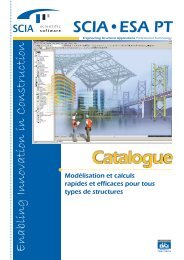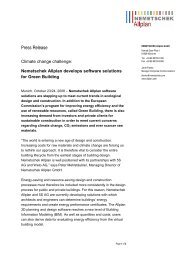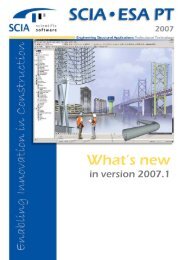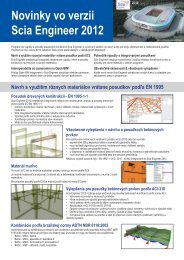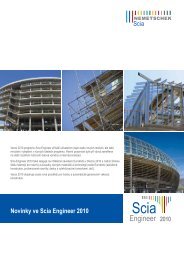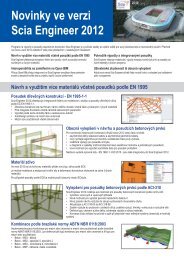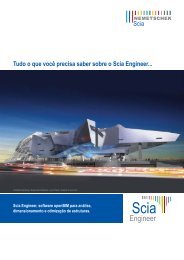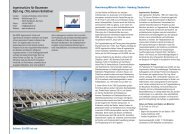VSH Turòa nad Bodvou - Nemetschek Scia
VSH Turòa nad Bodvou - Nemetschek Scia
VSH Turòa nad Bodvou - Nemetschek Scia
You also want an ePaper? Increase the reach of your titles
YUMPU automatically turns print PDFs into web optimized ePapers that Google loves.
Type: Arched bridge<br />
Location: Schaarbeek, Belgium (L36N between Brussels-North<br />
and Diegem)<br />
Owner: Infrabel, Belgium<br />
Architect: Tuc Rail, Belgium<br />
Erection Engineering: Ingenieursbureau STENDESS N.V.,<br />
Lovendegem, Belgium<br />
Check of the bridge during erection<br />
Contractor: Victor Buyck Steel Construction N.V., Eeklo, Belgium<br />
Total steel weight: ± 1.650 tons<br />
Total length: 136 m<br />
Building period: 2005<br />
Short description of the project<br />
It concerns the launching of a new bridge for the use of HST (High<br />
Speed Train) traffic at Schaarbeek, Brussels. The new bridge is an<br />
arched bridge with an orthotropic deck. The arches are built-up<br />
box girders. The main beams are built-up I-sections underneath the<br />
orthotropic deck.<br />
In order to reduce the disturbance of the train traffic under the<br />
bridge, the new arched bridge was erected on a newly build<br />
concrete bridge. On this concrete bridge the new arched bridge<br />
was built together and prepared for launching.<br />
Between the existing train tracks erection towers with skids were<br />
built to support the new bridge during launching. The positions of<br />
these erection towers were very non symmetrical because of the<br />
high density of tracks below. This caused an extra difficulty in the<br />
engineering study of the bridge launching.<br />
Ingenieursbureau Stendess N.V. was asked to check the new<br />
bridge during launching and to calculate and propose solutions<br />
for a safe launching.<br />
Several options were calculated and discussed with Victor Buyck<br />
Steel Construction. Challenges like global and local reinforcement<br />
of the main beam and launching with a launching nose lengths<br />
from 10 to 30 m, were investigated and judged. The solution with<br />
a launching nose of 30 m long was chosen. Because of the risk<br />
of buckling the buckling length of the bridge, diagonals were<br />
reduced by placing a horizontal lattice girder.<br />
During the launching, the reactions and the deformations of<br />
the bridge and launching nose were constantly compared with<br />
the calculated values in order to secure a safe launching. The<br />
launching itself was done smoothly and within 7 hours the bridge<br />
was in place.<br />
Use of ESA-Prima Win and SCIA•ESA PT<br />
Description of technical questions to be solved with<br />
ESA-Prima Win<br />
The complete 3D-model was formed with bars, the orthotropic<br />
deck plate was put together as 2D-elements. To realize a realistic<br />
behaviour of the bridge it was necessary to calculate and correct<br />
Launching of arched bridge LN36 Schaarbeek, Belgium<br />
the effective width of the upper flange of the main beams along<br />
the whole bridge length and this for each launching phase. The<br />
effective widths were calculated according EC3 and based upon<br />
the M-lines in the main beam obtained by ESA-Prima Win. The<br />
corrections of the effective width could be easily done by the “rib”<br />
module in ESA-Prima Win.<br />
To avoid overload of the concrete bridge on which the launching<br />
started and on the erection towers it was necessary to perform<br />
constantly corrections with regard to altitude, real precision work.<br />
The input in EPW and obtaining the results of these altitude corrections<br />
out of ESA-Prima Win went smoothly.<br />
The check of the local impact of the reactions into bridge was done<br />
based on EC3 with the use of the results given by ESA-Prima Win.<br />
The altitude corrections, the reactions on the erection towers and<br />
the deformation of the launching nose were calculated for each<br />
launching phase. The results obtained from ESA-Prima Win could<br />
easily be put in table and graphics in order to obtain a document in<br />
which theory and praxis during the launching could be compared<br />
and a safe launching was possible.<br />
Description of our experience with Esa-Prima Win when<br />
realizing the project<br />
• Checking the structure as a combined model with 1D-2D-3D<br />
elements and with a high hyperstatic degree according EC 3.<br />
• The possibility of building up a flexible model to simulate the<br />
different altitude correction on the erection towers.<br />
• The possibility of changing the effective width of the orthotropic<br />
deck along the bridge length.<br />
• The short calculation time for the model pro launching phase<br />
and the easy and fast way to do a global check according<br />
EC 3. This was very important because of the high number of<br />
launching phases to be considered.<br />
Used modules<br />
• Base<br />
• 3D frame<br />
• 3D shell<br />
• Steel code check (EC3)<br />
215




